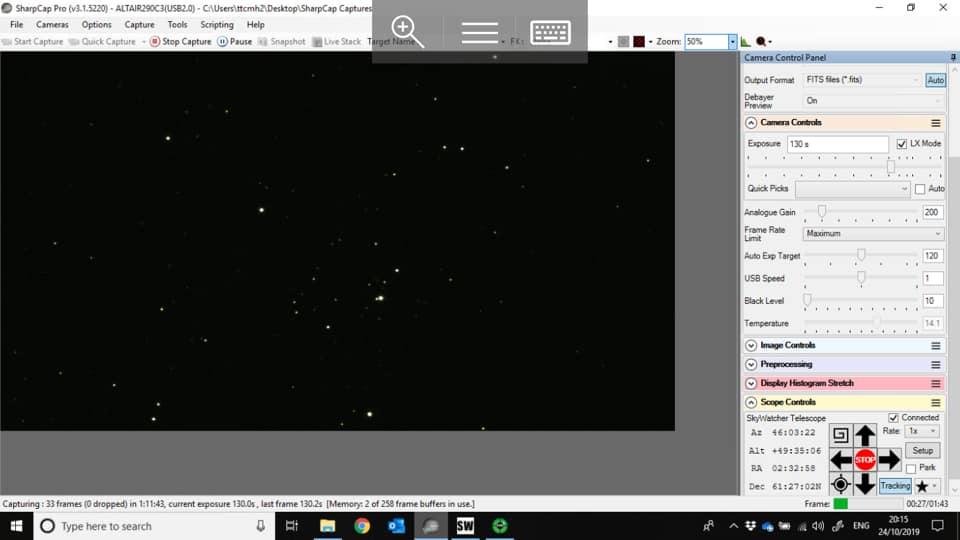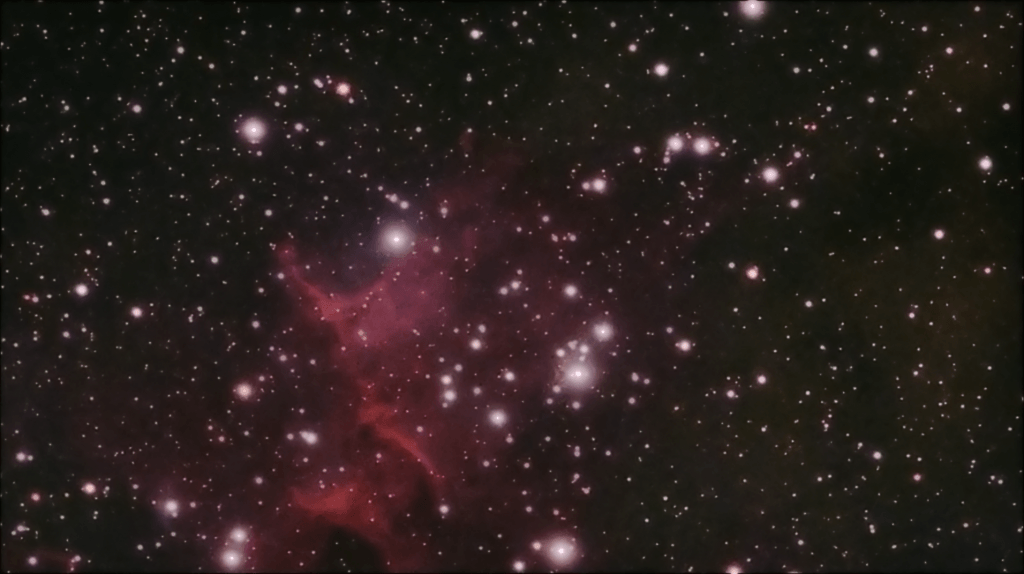This astrophotograph shows the open cluster of stars Melotte 15, which lies at the centre of the large emission nebula called the Heart Nebula (IC 1805). It is the radiation from this cluster of stars that ionises the surrounding hydrogen gas to give it its intense red and pink colours and reveal its dark dust lanes. The brightest stars in Melotte 15 are nearly 50 times the mass of our Sun, but there are also many more dim stars (some but not all visible in this photo) which are only a fraction of our Sun’s mass. Melotte 15 lies 7500 light years away from Earth inside the Milky Way galaxy, and appears in the constellation Cassiopeia.
The whole Heart Nebula is enormous. This zoomed-in photograph of the star cluster at its centre has apparent dimensions of approximately 27×15 arcminutes. In comparison, the whole Heart Nebula has apparent dimensions of approximately 150×150 arcminutes, which is more DSLR territory rather than telescope work.
Data capture

My 102mm f/7 refractor telescope and 60mm guidescope, somewhat under-mounted on the Eq5, but as the PHD2 guiding readout shows, it copes OK. 
Guiding in PHD2. The view through the guidescope is in the top left, with the guide star under the crosshairs. The guiding accuracy is shown by the graph. The flatter the red and green lines the more accurate the guiding (i.e. so the image doesn’t streak). 
Data capture in SharpCap Pro.
Calibration frame problems
Although I ended up using the flat frames, dark flat frames and bias frames collected on 8 September 2019, I did actually capture a full set of calibration frames specifically for this project. Unfortunately I think I had two separate problems with them, and I ended up rejecting them:
- Flat frame over-correction. Flat frames correct the final image for vignetting and shadows caused by dust motes on the lenses, camera sensor, etc. In this case, however, including flat frames in DeepSkyStacker left bright artefacts on the final image in the same places where the master flat frame shows shadows. If, however, I revert back to an old master flat frame from 8 September then the problem disappears. The new master flat frame shows an extra couple of dark shadows in comparison to the one from 8 September. All I can think is that the some part of the optical train acquired some extra dust motes just before I took the flat frames, so that the light frames would be largely unaffected while the flat frames would be.
- Excessive read noise in the bias frames. To help keep the mount steady and improve guiding accuracy, I recently bought USB extension cables for my cameras so that I could keep the camera cables tidy and secure by routing them up the leg of the tripod. (The weight of cables, and their tendency to blow in the wind can have a really detrimental effect on guiding.) Unfortunately I bought USB 2.0 extension cables (instead of USB 3.0) and it seems that their slower data rate means that sensor’s pixel wells for collecting light data information don’t have enough time to flush out properly after each frame. It leaves a really strong gradient in the bias frames going bright to dark from left to right across the sensor. I don’t know if it affects other types of calibration frame too, but next time I will try leaving a gap of a few seconds between frames to see if that gives the pixel wells enough time to flush.
Frames
- 91× 130-s light frames
- 37× dark frames
- Flat frames, dark flat frames and bias frames from 8 September 2019
Equipment
- Explore Scientific ED 102 mm Apo f/7 refractor
- Sky-Watcher EQ5 PRO SynScan GOTO equatorial mount
- Altair GPCAM3 290C colour camera (with UVIR window fitted)
- Altair 60mm guide scope
- Altair GPCAM2 AR0130 mono guide camera
Software
- Sharpcap
- PHD2
- DeepSkyStacker
- Photoshop


